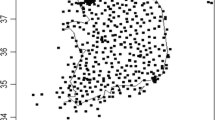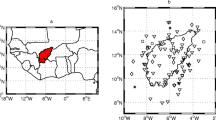Abstract
Using geographic information system (GIS) techniques and the newest seasonal and annual average precipitation data of 679 meteorological stations from 1971 to 2000, the multiple regressions equations of the precipitation and topographical variables are established to extract the effect of topography on the annual and seasonal precipitation in the upper-middle reaches of the Yangtze River. Then, this paper uses a successive interpolation approach (SIA), which combines GIS techniques with the multiple regressions, to improve the accuracy of the spatial interpolation of annual and seasonal rainfall. The results are very satisfactory in the case of seasonal rainfall, with the relative error of 6.86%, the absolute error of 13.07 mm, the average coefficient of variation of 0.070, and the correlation coefficient of 0.9675; in the case of annual precipitation, with the relative error of 7.34%, the absolute error of 72.1 mm, the average coefficient of variation of 0.092, and the correlation coefficient of 0.9605. The analyses of annual mean precipitation show that the SIA calculation of 3–5 steps considerably improves the interpolation accuracy, decreasing the absolute error from 211.0 mm to 62.4 mm, the relative error from 20.74% to 5.97%, the coefficient of variation from 0.2312 to 0.0761, and increasing the correlation coefficient from 0.5467 to 0.9619. The SIA iterative results after 50 steps identically converge to the observed precipitation.
Similar content being viewed by others
References
Basist A, Bell G D, Meentenmeyer V, 1994. Statistical relationships between topography and precipitation patterns.J. Clim., 7(9): 1305–1315.
Burrough P A, 1986. Principles of Geographical Information Systems for Land Resources Assessment. Clarendon Press, 147–165.
Chang Yu, Su Guiwei, 1996. The study on the scale analysis methodology of the spatial extension of station data: a case of Liaoning Province.The Dynamic Study of the Resource Biology Environment Network, 7(1): 8–15.
Dai Ruolan, Liang Tiangang, Xu Yuqinget al., 1999. The research of the assessment methodology of precipitation resource for the convergent agriculture.Journal of Lanzhou University, 35(1): 165–170. (in Chinese)
Editorial Committee of Climatological Atlas of the People’s Republic of China, 2002. Climatological Atlas of the People’s Republic of China. Beijing: China Meteorological Press, 49–57. (in Chinese)
Feng Zhiming, Yang Yanzhao, Ding Xiaoqiang, 2004. Optimization of the spatial interpolation for climate resources.Geographical Research, 23(3): 357–364. (in Chinese)
Franre R, 1982. Smooth interpolation of scattered path by local thin plate splines.Comp & Maths with Appls Great Britain, 8(4): 237–281.
Fu Baofu, 1992. The effect of topography and elevation on the precipitation.Acta Geographica Sinica, 47: 302–314. (in Chinese)
Germann U, Joss J, 2000. Spatial continuity of alpine precipitation.Phys. Chem. Earth, (B), 25: 903–908.
Goodale C L, Alber J D, Ollinger S V, 1998. Mapping monthly precipitation, temperature and solar radiation for Ireland with polynomial regression and digital elevation model.Clim. Res., 10: 35–49.
Goovaerts P, 2000. Geostatistical approaches for incorporating elevation into the spatial interpolation of rainfall.J. Hydrol., 228: 113–129.
Jiang Zongxin, 1989. The discussion on the precipitation vertical distribution in mountainous area.Geographical Research, 7(1): 73–77. (in Chinese)
Kurtzman D, Kadmon R, 1999. Mapping of temperature variables in Israel: a comparison of different interpolation methods.Clim. Res., 13: 33–43.
Lakshmi, 2000. Introduction. In: V Lakshmi, J Albertson, J Schaake (eds.), Land Surface Hydrology, Meteorology, and Climate: Observations and Modeling, AGU, 1–4.
Li Jiangfeng, 1988. The Study on the Drought and Semi-drought Climate and Environment Regional Development in China. Beijing: China Meteorological Press, 117–121. (in Chinese)
Li Xin, Chen Guodong, Lu Ling, 2003. The interpolation method comparison for temperature distribution in Tibetan Plateau.J. of Plateau Meteorology, 22(6): 565–573. (in Chinese)
Li Zhengquan, Yu Guirui, Liu Xinanet al., 2003. The rasterization technique of the precipitation and humidity climate data in Northeast China.Resources Science, 25(1): 165–170. (in Chinese)
Liang Tiangang, Wang Xizhi, Dai Ruolan, 2002. The study on the simulation methodology of the spatial change of multi-year average precipitation resource.Acta Botanica Boreali-Occidentalia Sinica, 20(5): 856–862.
Lin Zhiguang, 1995. Topographical Precipitation Climatology. Beijing: Science Press, 156–210. (in Chinese)
Lin Zonghui, Mo Xingguo, Li Hongxuanet al., 2002. The interpolation of meteorological factors in the land region of China.Acta Geographica Sinica, 57(1): 47–56. (in Chinese)
Lu Qirao, Fu Baofu, Yu Jingming, 1990. The estimation method of agro-climate resources in mountain area and the climate effect of micro-topography.Chinese Journal of Agrometeorology, 9(2): 27–32. (in Chinese)
Marquínez J, Lastra J, Garcia P, 2003. Estimation models for precipitation in mountainous regions: the use of GIS and multivariate analysis.J. Hydrol., 270: 1–11.
Martinez-Cob A, 1996. Multivariate geostatistical analysis of evapotranspiration and precipitation in mountainous terrain.J. Hydrol., 174(1–2): 19–35.
Ninyerola M, Pons X, Roure J M, 2000. A methodological approach of climatological modeling of air temperature and precipitation through GIS techniques.Int. J. Climatol., 20(14): 1823–1841.
Oliver M, Kriging A, 1990. A method of interpolation for geographical information systems.International Journal of Geographic Information Systems, 4(4): 313–332.
Prodhomme C, Duncan W R, 1999. Mapping extreme rainfall in a mountainous region using geostatistical techniques: a case study in Scotland.Int. J. Climatol., 19(12): 1337–1356.
Ren Chuanyou, 2000. The temperature and corn species distributions at 10 × 10 km grids of Liaoning Province.Acta Meteorologica Sinica, 58(suppl.): 918–927. (in Chinese)
Sevruk B, Nevenic M, 1998. The geography and topography effects on the areal pattern of precipitation in a small prealpine basin.Wat. Sci. Tech., 37: 163–170.
Shang Zongbo, Gao Liang, Yang Dianan, 2001. The study on the precipitation spatial distribution by using the climate information system in China.Acta Ecologica Sinica, 21(5): 689–694.
Waston D F, Philip G M A, 1985. Refinement of inverse distance weighted interpolation.Geoprocessing, (2): 315–327.
Weisse A K, Bois P, 2001. Topographic effects on statistical characteristics of heavy rainfall and mapping in the French Alps.J. Appl. Meteorol., 40(4): 720–740.
Wolting G, Bouvier C, Danloux Jet al., 2000. Regionalization of extreme precipitation distribution using the principal components of the topographical environment.Journal of Hydrology, 233: 86–101.
Xue Genyuan, Zhou Suoquan, Liang Xuet al., 2004. The improved projects considering complicated terrain conditions used to analyze spatial interpolation of climate variables.Science and Technology Review, (8): 42–46.
Zhang Liangqiang, Zhao Youzhong, Ouyang Zongjiet al., 1996. The research of the local precipitation estimation by using geographical factors in mountain area.Chinese Journal of Agrometeorology, 17(2): 6–10. (in Chinese)
Zhou Suoquan, Miao Qilong, 1993a. Microscale grids method of calculating sunshine percentage.Scientia Meteorologica Sinica, 16(3): 26–48. (in Chinese)
Zhou Suoquan, Miao Qilong, 1993b. The small grid analysis meteorology of total radiation in mountain.Weather on Plateau in Lower Latitudes, 6: 55–60. (in Chinese)
Zhou Suoquan, Miao Qilong, 1995. The small grid analysis methodology of precipitation resource in mountain area. In: The Utilization and Development for Climate Resource. Beijing: China Meteorological Press, 242pp.
Zhuang Liwei, Wang Shili, 2003. The research on the spatial interpolation methodology for daily meteorological factors in Northeast China.Quarterly Journal of Applied Meteorology, 14(5): 606–615. (in Chinese)
Author information
Authors and Affiliations
Corresponding author
Additional information
Foundation: The National 973 Project of China, No.2001CB309404; Oversea Outstanding Youth Cooperation Project, No.40128001/D05; National Natural Science Foundation of China, No.49375248; Zhejiang Province Science Research (C33) Project, No.2004C33082
Author: Zhou Suoquan (1961–), Ph.D. and Professor, specialized in the analysis and study on climatic resources.
Rights and permissions
About this article
Cite this article
Zhou, S., Xue, G., Gong, P. et al. The SIA method for spatial analysis of precipitation in the upper-middle reaches of the Yangtze River. J. Geogr. Sci. 15, 223–238 (2005). https://doi.org/10.1007/BF02872688
Received:
Accepted:
Issue Date:
DOI: https://doi.org/10.1007/BF02872688




